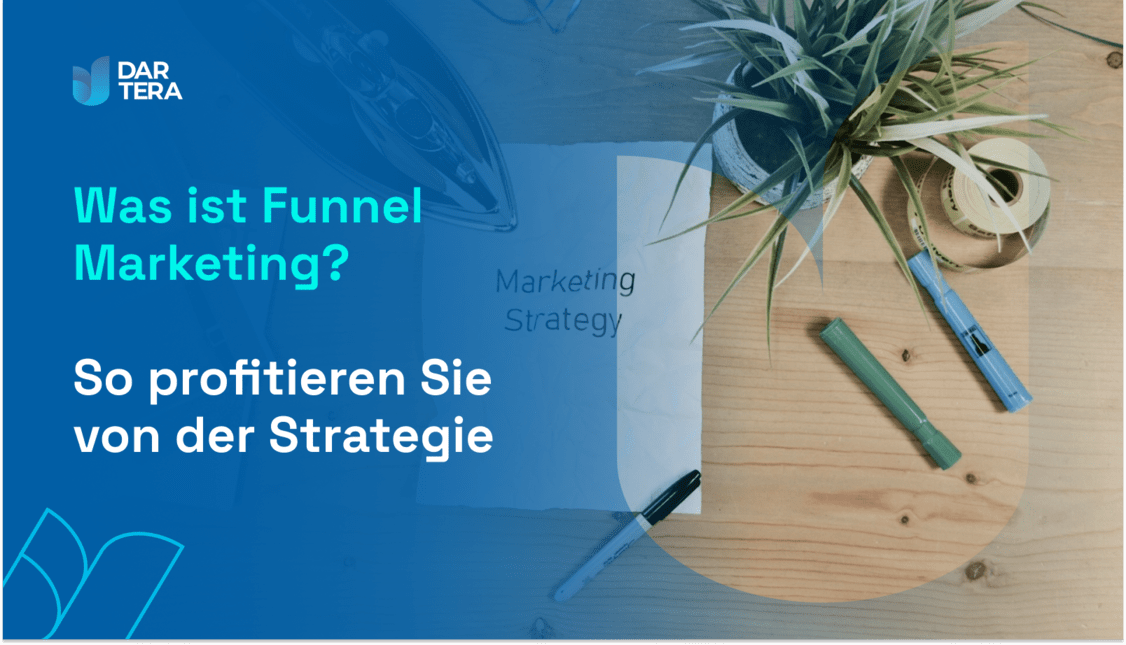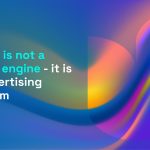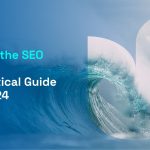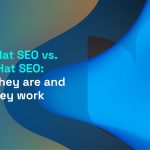What is funnel marketing? How you benefit from the advertising strategy

Funnel marketing is a systematic approach in digital marketing to gradually convert visitors into customers. The method involves guiding potential customers along the customer journey. This process typically comprises the awareness, interest, decision, purchase and loyalty phases.
In this blog post, we want to explain to you what exactly the concept of the marketing funnel means. We will go into the individual phases of the marketing funnel and show you step by step how you can benefit from digital funnel marketing!
Marketing and sales funnel definition
Advertising funnel and co. refer to a systematic marketing strategy with which we gradually convert visitors into customers. The basic idea is to guide potential customers along a "marketing funnel" - from the first contact to the purchase and beyond.
Digital marketing funnel explained in more detail
A marketing funnel / sales funnel is therefore a process that is designed to gradually turn visitors into customers. But how exactly does it work? What is important in a funnel and what marketing aspects need to be considered?
Such an advertising funnel in the marketing sector typically consists of 5 phases, which we would like to take a closer look at with you below. Each phase is underpinned by specific marketing activities and goals in order to bring interested parties closer to converting into paying customers. In online marketing, the following steps are important.
Phase 1: Awareness: Creating awareness for your own brand
The awareness phase is about making the target group aware of your brand or offer in the first place. This means that you now want to create awareness of your business, product or service.
Potential customers can be found and reached through relevant search terms tailored to your desired group . The most important measures include professional content creation and the placement of paid ads to attract potential customers to your website.
The aim is to build visibility and awareness for the brand. Successful content is attractively designed and triggers real interest in the reader. In addition to blog articles, well-produced videos or eBook downloads are also suitable.
The visual presentation also plays a role. Concise headlines, meaningful images and short paragraphs ensure high readability. In social media and on the website, content should be easily shareable using share buttons and similar call-to-actions.
The choice of channels depends on where your target group usually hangs out. In addition to your own website, channels such as YouTube, Instagram or LinkedIn are suitable in many industries. By regularly publishing fresh content, the topic and the brand remain present and you can keep your customers on the online journey.
Phase 2: Arouse interest through customer funnel and problem solving
Once awareness has been created, the next phase is about arousing actual interest among visitors. This is precisely what turns visitors into real users or buyers. Presenting your solution to a specific problem can also arouse the interest of potential buyers. The customer journey and the presentation of your solution are crucial for arousing interest.
Call-to-action, such as offering whitepapers or e-books on specific topics, should contribute to the decision-making process and are an important part of the marketing strategy. At the same time, it is important to use case studies, sample applications and video tutorials to make a concrete benefit recognizable for the target group. Detailed cases and test reports illustrate the added value in practice.
In order to generate interest, it is important to create exciting and appealing content. Value propositions should always be at the forefront. Interactive elements such as quizzes or checklists help to motivate participants.
In addition to the actual funnel, landing pages and email campaigns should be used to target existing contacts. The focus here is on value-added offers such as checklists or downloadable tools. Teaser-type videos can be used in social media to arouse curiosity and at the same time direct people to the website. Comments and likes in the community increase visibility.
In addition, cookies and tracking tools should be used to recognize prospective customers across different channels and always provide them with new offers tailored to their needs.
Phase 3: Decision through the marketing funnel
In the decision-making phase, the aim is to persuade potential customers to move from a purely informational level to an active purchase review. They should be convinced of the idea behind the product and encouraged to carry out their own research.
An important step here is to provide concrete benefit arguments. Instead of talking abstractly about features and functions, the focus must be on the specific benefit for the potential customer. For example, how can your offering simplify processes or generate more sales?
At the same time, it is important to clarify any concerns or uncertainties that customers may have. These could be cost aspects or perceived risks during the changeover, for example. Transparent risk minimization such as test phases can counteract this.
Personal contacts (by email, telephone or social media) also become more important in this phase. The individual added value for each customer is emphasized in consultations or demonstrations. In this way, the customer gradually becomes convinced that they can achieve their goals by working with us.
Phase 4: Purchase through conversion funnel
The purchase is the goal of the entire process. The customer journey went well, which is why the interested parties have now decided to buy. Now, of course, it should not fail due to errors on the website or issues with the payment process.
To complete the customer journey with a purchase, the added value of your own offer must be proven through tests and examples. Various purchase options such as several payment options or delivery models can support the purchase decision. Make the entire purchasing process as simple and smooth as possible to optimize the conversion rate.
Inform your customers about the entire product range. Product detail pages play a decisive role here. In addition to technical data, specific benefit aspects should always be communicated. If possible, offer buyers trial versions or free tools to make the added value tangible in advance.
In your online store, you should place particular emphasis on clarity, security and payment options. Check-out wizards simplify the process. Attractive introductory prices can drive up conversion.
Personal support, such as via chat or telephone, also helps to clarify any remaining questions and enable sales to be concluded. Transaction confirmations and the immediate availability of services increase customer satisfaction. The same applies to attractive delivery and payment terms.
Regular analyses of the conversion rate allow targeted optimization based on the data. In this way, the conversion rate can be increased step by step.
Phase 5: Loyalty through content marketing
It continues even after the purchase, because satisfied customers are the best form of marketing. Loyalty can be built up and increased through remarketing, content marketing and feedback processes . This ensures more sales and turnover for your company in the long term . Regular customer surveys provide information about the actual customer experience, giving you the opportunity to constantly optimize your processes. This in turn - as you can probably already imagine - ensures happy customers and greater growth in your customer base. This increases the credibility of your company and ensures more purchases.
To keep loyalty high, it makes sense to offer exclusive additional services for existing customers, for example. Targeted campaigns to reactivate older customers can generate additional sales. A sense of community can be created via social media or a blog (articles on various topics worth knowing about). Updates and support also help to maintain customer satisfaction. Last but not least, content that focuses on specific solutions to the target group's problems ensures lasting engagement. An
Understanding target groups in the lead conversion funnel
In marketing practice, the phases of the consumer funnel are often referred to as the top, middle and bottom funnel .
For potential customers, Top of the Funnel (ToFu) is at the beginning of their decision-making process. They are at the very top of the marketing funnel and their brand loyalty is still low.
Middle of the Funnel (MoFu) symbolizes interested customers who are already researching a possible solution but are not yet ready to make a final decision. They pass through the middle of the marketing funnel.
Bottom of the funnel (BoFu) refers to existing customers who are already using the solution. They are at the "bottom" of the funnel and have usually built up a strong brand preference. Such a customer is a successful funnel lead who, in the best case, will return or use your service on an ongoing basis.
The further a customer progresses from the top to the bottom funnel, the more personalized and targeted the marketing activities need to be. Top-funnel customers initially require broad brand awareness. In the MoFu, prospective customers can be won over through facts and trust. BoFu customers expect added value through exclusive services. Only those who understand the differences between the target groups can manage them efficiently in the marketing process and achieve high sales rates.
Sales funnel marketing: optimizing the awareness phase
As we have now learned, the entire process of funnel system marketing begins with this sales funnel marketing phase. That's why this part of the advertising strategy should be particularly effective! A few tips and tricks are required to implement a successful strategy.

How to improve your funnel system marketing
In order to reach potential customers at all during the awareness phase, sound planning is essential. The first step is to
Examples of suitable marketing funnel tools:
- Google Trends: Shows topics that are gaining or losing popularity based on Google search queries
- SEMrush: Comprehensive tool for keyword research and tracking trends and competitors
- Buzzsumo: Analysis of the most shared and discussed content on specific topics
- Google Alerts: Sends notifications for new entries that contain certain search terms
This research can be used to identify the relevant topics for your own offering. These findings are then incorporated into content creation, the design of marketing material and online visibility.
Valuable and user-oriented content such as e-books, videos or specialist articles help to get users interested in your own solutions or product. At the same time, paid advertisements can ensure that the right target group becomes aware of your information.
Tests and measurements can be used to determine whether the content actually arouses interest and leads people to your website. Only through continuous optimization based on data can the visibility and thus the effect of the measures be improved.
Identify relevant search terms
With the help of the aforementioned keyword research tools such as SEMrush or Buzzsumo, you can now determine the most popular and most searched keywords in the context of your marketing funnel. Of course, you should check these for their relevance to your offer and your target group.
It is important that the keywords have a sufficiently high monthly search volume and ideally have already generated conversions in the past. In addition, their content focus should perfectly match your service portfolio and the desired customer group.
After this filtering process, the keywords that offer the greatest chance of successful placement and corresponding leads remain. These must then be prioritized in the further strategy. By constantly adding to and adapting the keyword pool, its topicality and performance can be ensured on an ongoing basis.
Plan and create content
With the keyword list compiled, it is now time to develop specific content . A balanced mix of formats such as blog articles, whitepapers, e-books, guides and case studies should be created.
You should design your content in such a way that it offers real added value for readers and answers key questions from your target group. How do you improve your marketing funnel? For example, by presenting
Graphic elements, videos and infographics help to present information clearly and make it easier to understand. After completion, the content needs to be clearly integrated into your website and optimized for the relevant keywords.
Regular updates and enhancements ensure constant added value and better figures in the marketing funnel. In this way, interested parties can be encouraged to convert and readers can be motivated to return.
Paid ads on Google and Facebook: Increase the success of your marketing funnel
In addition, Google Ads and Facebook Ads can be used to target potential customers and lead them to content. The key here is to align the ad texts very precisely with the target group and the benefits of the solution or product.
Topics such as the efficient increase in lead generation or the successful support of interested parties along the entire customer process should be addressed in the ad texts. In this way, traffic can be directed to the website and new contacts can be gained.
In some cases, it can also make sense to use a funnel marketing agency to develop a targeted and promising strategy.
Conclusion: Marketing funnel for more business success
To summarize, funnel marketing is a systematic approach to guide potential customers along the customer journey through target-group-specific communication to purchase and long-term customer loyalty. Regular optimization and measurement are the key to success. Because the process of the marketing funnel never ends, it is a continuous growth of your customers and your company!
FAQ
What is the funnel method?
In marketing, this method describes the systematic process of persuading potential customers to make a purchase or increase customer loyalty through targeted measures at various stages. Interested parties are gradually guided further along the customer journey.
What exactly is full funnel marketing?
This term refers to the targeted addressing of potential customers in all phases of the marketing funnel - from ToFu to MoFu to BoFu. This is the only way to professionally accompany the entire customer journey and achieve a high conversion rate.
What is the SEO funnel in marketing?
The SEO funnel describes the application of search engine optimization along the various phases of the marketing funnel. The aim is to gradually bring potential customers from organic search results closer to the company.
What is a good example of a funnel marketing strategy?
Large e-commerce providers such as Amazon are a successful example of the implementation of this concept. They provide targeted support to prospective customers, from product inspiration and purchase through to upselling or cross-selling additional products.







